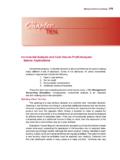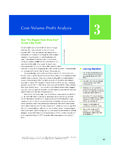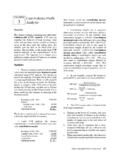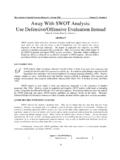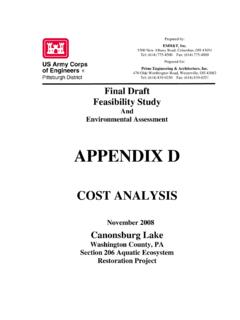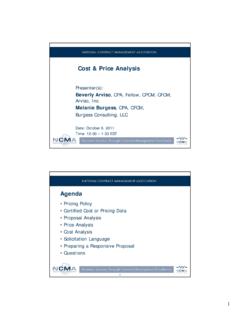Transcription of A COST MODEL FOR THE IT DEPARTMENT - JAQM
1 Software analysis A cost MODEL FOR THE IT DEPARTMENT . Marius MIHUT1. Economic Informatics DEPARTMENT , Babe -Bolyai University of Cluj-Napoca, Cluj-Napoca, Romania. E-mail: Nicolae TOMAI2. Economic Informatics DEPARTMENT , Babe -Bolyai University of Cluj-Napoca, Cluj-Napoca, Romania. E-mail: Abstract: Traditionally, it is believed that a busy IT DEPARTMENT (Information Technology DEPARTMENT ) of an organization, with many services offered for other departments is very profitable, or at least cost -effective . A real and precise calculation of costs per product or service have unveiled that the above is not necessarily true. Activity-Based Costing is a costing MODEL that could assign precise costs to products and services.
2 The combination of this method with the MODEL for calculating the total cost of an IT. DEPARTMENT , proposed by HP Laboratories in [1] is a powerful tool for improving IT services. Keywords: cost MODEL ; IT DEPARTMENT cost MODEL ; Activity-Based Costing; cost Object;. cost drivers 1. Introduction The need for a cost MODEL is given by the fact that it is necessary to identify the cost for each product or service in order to identify the profitability of IT activities and processes. The objective of this paper is to introduce a precise method for calculating the costs of operating an IT DEPARTMENT . The method described in this paper extends the cost MODEL proposed by HP Laboratories [1] with the Activity-Based Costing method to determine the real cost for each product or service.
3 Practically, the costs calculated using HP method are tracked in activities and work processes. 2. The HP cost MODEL for planning, development and operation of a Data Center The cost MODEL proposed by HP Laboratories take into account all costs which are involved in operating the data center of an organization: cost of power delivery, cost of cooling, cost of space and cost of operation. For many organizations, data centers are their own IT DEPARTMENT . The total cost of ownership of an IT DEPARTMENT is summarized in [1]as follows: cost total = cost space + cost power the hardware + cost cooling + cost operation (1). 358. Software analysis Each of these costs express the amount of correspondent resource, consumed by the data center in a specific period of time.
4 The methods for calculating them are detailed in [1]: - Typically, the cost of space includes the cost of real estate necessary for the data center, for power generation systems and other auxiliary subsystems. It is considered that operating income is realized only in that portion of the data center space which is populated with computing equipment;. - cost of power delivery includes conditioning, battery back-up, on-site power generation, and redundancy in both delivery as well as generation;. - cost of cooling is the cost of power consumed by the cooling resources;. - cost of operation includes personnel costs, depreciation of IT Equipment, software and licensing costs.
5 This MODEL offers a method for calculating the total costs of a data center. It could be also used to calculating the total costs of an IT DEPARTMENT . However, there is a strong need for calculating the cost of each service or product, in order to measure the performance of the IT DEPARTMENT . To do that, it is necessary to calculate the exact consumption of each resource presented in relation (1) for obtaining an output (product or service). In other words, the indirect costs from (1) must be transformed in direct costs. 3. Activity-Based Costing method Activity-Based Costing (ABC) is a cost accounting method used for understanding product, service and customer cost and profitability.
6 Activity-Based Costing was first described in [2]. In IT domain, the directions of use for this method are: - Supporting management decision regarding price, outsourcing or cost and revenue improvement;. - Improving IT processes;. - Calculating the cost of IT services. Key elements of this method are activity and cost driver. Activity is defined as a set of complementary tasks, which are done with a specific purpose. cost driver express the relation between an output (product or service) and the activities consumed by it. cost objects represents batches, activities, processes, products, services, customers and suppliers. This method was developed because the traditional accounting system has a weakness with the assignment of indirect costs.
7 Indirect costs are the expenses that don't directly generate profit, but are necessary for an organization (or DEPARTMENT ) to continue activity. Traditional accounting method arbitrarily allocates indirect costs to cost objects. Therefore, as the indirect costs increase, the traditional method will yield a less accurate result for the true cost of a cost object. The ABC method solves this problem by transforming indirect costs to direct ones. It traces, rather than allocates, each expense category to a cost object. This method is applicable when indirect costs are greater than direct costs with 20 percents or more. Essentially, this method groups the costs in activity pools instead of collecting them as indirect costs of a DEPARTMENT .
8 Similar processes or activities, which are driven by a common factor, are grouped in the same pool. Next step is to distribute collected costs to each product or service, by using a cost driver, as it is shown in relation 2: Unit cost driver cost = cost activity pool / Quantity driver cost (2). A cost driver is the common factor that groups activities or processes in a specific pool. Examples of cost drivers include: number of setups, number of tests, number of inspections, number of uptime hours for servers or computers, number of failures, number of cycle times, cost of providing resources, The total cost for each pool is distributed to products or services using the volume of cost driver assigned to the pool.
9 For example, if 359. Software analysis testing a server requires 30 percent of the testing activity and the cost driver is the number of tests, then the cost of the testing a server activity is 30 percent of the testing costs. The differences between the ABC and the traditional costing methods are discussed in reference [3]. These are also summarized below in table 1. Table 1. Difference between ABC and Traditional costing [3]. ABC method Traditional costing method cost pools Costs are grouped into Costs are grouped in pools using activity cost pools, which departmental costs. The cost pools correspond to the major activities are very heterogeneous and are or business processes.
10 Not caused by a single factor. Allocation bases Costs are allocated to products or Costs are allocated to products or services by using cost drivers services by using arbitrary percentage (based on products or services volumes). cost Objects Intend to calculate the real cost Calculate the arbitrarily cost of a of cost objects (activities, cost object (either product or processes, products, services). service). cost Drivers Used to group costs into activity Used to group costs into cost pool indirect/fixed costs. Decision support Can support strategic decisions Can cause problems of overcosting with accurate information, because and undercosting because of the of the ability to align allocation inability to align allocation bases bases with cost drivers.


